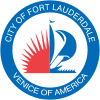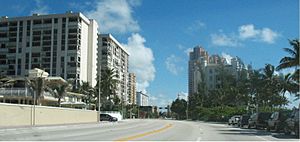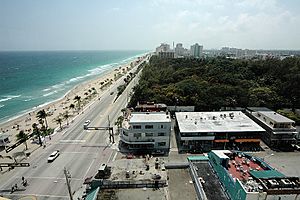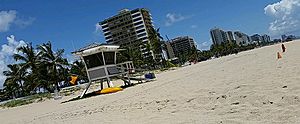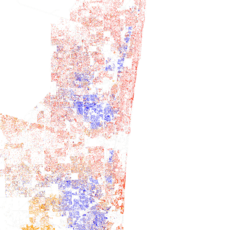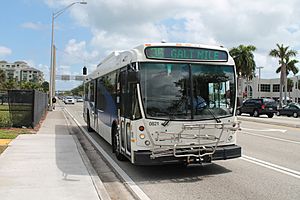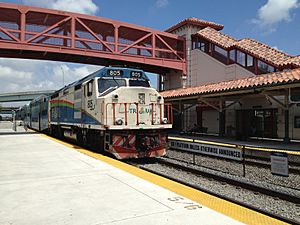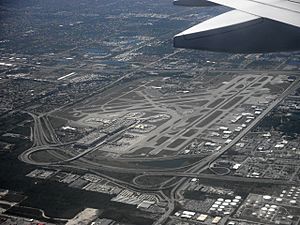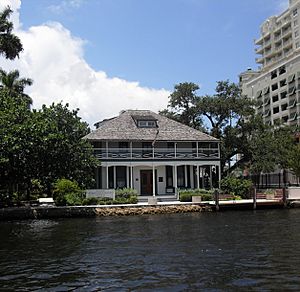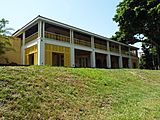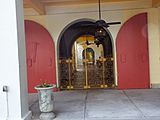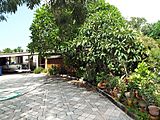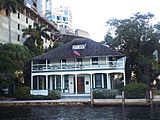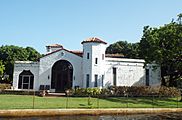Fort Lauderdale, Florida facts for kids
Quick facts for kids
Fort Lauderdale
|
|||
|---|---|---|---|
| City of Fort Lauderdale | |||
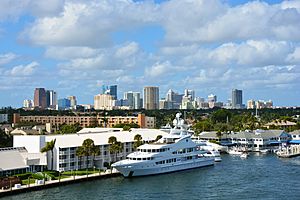
Downtown Fort Lauderdale
|
|||
|
|||
| Nickname(s):
Venice of America
|
|||
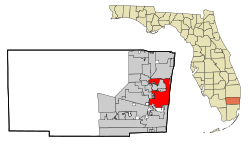 |
|||
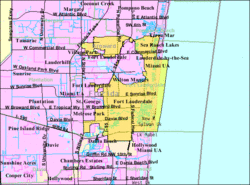
U.S. Census Bureau map
|
|||
| Country | |||
| State | |||
| County | |||
| Established | March 27, 1911 | ||
| Government | |||
| • Type | Commission-Manager | ||
| Area | |||
| • City | 36.30 sq mi (94.01 km2) | ||
| • Land | 34.59 sq mi (89.58 km2) | ||
| • Water | 1.71 sq mi (4.44 km2) 9.87% | ||
| Elevation | 9 ft (2.75 m) | ||
| Population
(2020)
|
|||
| • City | 182,760 | ||
| • Density | 5,284.07/sq mi (2,040.21/km2) | ||
| • Metro | 6,138,333 (US: 8th) | ||
| Time zone | UTC−5 (Eastern (EST)) | ||
| • Summer (DST) | UTC−4 (EDT) | ||
| ZIP codes |
33301-33332, 33334-33340, 33345-33346, 33348-33349, 33351, 33355, 33359, 33388, 33394
|
||
| Area code(s) | 754, 954 | ||
| FIPS code | 12-24000 | ||
| GNIS feature ID | 0282693 | ||
| Primary Airport | Fort Lauderdale-Hollywood International Airport | ||
Fort Lauderdale ( also spelled Ft. Lauderdale) is a coastal city located in the U.S. state of Florida, 25 miles (40 km) north of Miami along the Atlantic Ocean. It is the county seat and largest city in Broward County with a population of 182,760 as of the 2020 Census making it the tenth largest city in Florida. Fort Lauderdale is the second largest and one of three principal cities comprising the Miami metropolitan area with a population of 6,166,488.
Built in 1838 and first incorporated in 1911, Fort Lauderdale is named after a series of forts built by the United States during the Second Seminole War. The forts took their name from Major William Lauderdale (1782–1838), younger brother of Lieutenant Colonel James Lauderdale. Development of the city did not begin until 50 years after the forts were abandoned at the end of the conflict. Three forts named "Fort Lauderdale" were constructed including the first at the fork of the New River, the second at Tarpon Bend on the New River between the present-day Colee Hammock and Rio Vista neighborhoods, and the third near the site of the Bahia Mar Marina.
Known as the “Venice of America," Fort Lauderdale has 165-miles of inland waterways across the city. In addition to tourism, Fort Lauderdale has a diversified economy including marine, manufacturing, finance, insurance, real estate, high technology, avionics/aerospace, film, and television production. The city is a popular tourist destination with an average year-round temperature of 75.5 °F (24.2 °C) and 3,000 hours of sunshine per year. Greater Fort Lauderdale, encompassing all of Broward County, hosted more than 13 million overnight visitors in 2018. Each year nearly 4 million cruise passengers pass through its Port Everglades, making it the third largest cruise port in the world. With over 50,000 registered yachts and 100 marinas, Fort Lauderdale is also known as the yachting capital of the world."
Contents
History
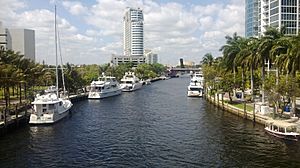
The area in which the city of Fort Lauderdale would later be founded was inhabited for more than two thousand years by the Tequesta Indians. By 1763, there were only a few Tequesta left in Florida, and most of them were evacuated to Cuba when the Spanish ceded Florida to the British in 1763, under the terms of the Treaty of Paris (1763), which ended the Seven Years' War. Although control of the area changed between Spain, United Kingdom, the United States, and the Confederate States of America, it remained largely undeveloped until the 20th century.
The Fort Lauderdale area was known as the "New River Settlement" before the 20th century. In the 1830s there were approximately 70 settlers living along the New River. William Cooley, the local Justice of the Peace, was a farmer and wrecker, who traded with the Seminole Indians. On January 6, 1836, while Cooley was leading an attempt to salvage a wrecked ship, a band of Seminoles attacked his farm, killing his wife and children, and the children's tutor. The other farms in the settlement were not attacked, but all the white residents in the area abandoned the settlement, fleeing first to the Cape Florida Lighthouse on Key Biscayne, and then to Key West.
The first United States stockade named Fort Lauderdale was built in 1838,
Fort Lauderdale's first major development began in the 1920s, during the Florida land boom of the 1920s. The 1926 Miami Hurricane and the Great Depression of the 1930s caused a great deal of economic dislocation.
When World War II began, Fort Lauderdale became a major US base, with a Naval Air Station to train pilots, radar operators, and fire control operators. A Coast Guard base at Port Everglades was also established.
On July 4, 1961 African Americans started a series of protests, wade-ins, at beaches that were off-limits to them, to protest "the failure of the county to build a road to the Negro beach". On July 11, 1962 a verdict by Ted Cabot went against the city's policy of racial segregation of public beaches.
Today, Fort Lauderdale is a major yachting center, one of the nation's largest tourist destinations, and the center of a metropolitan division with 1.8 million people.
Population size
After the war ended, service members returned to the area, spurring an enormous population explosion which dwarfed the 1920s boom. The 1960 Census counted 83,648 people in the city, about 230% of the 1950 figure. A 1967 report estimated that the city was approximately 85% developed, and the 1970 population figure was 139,590.
After 1970, as Fort Lauderdale became essentially built out, growth in the area shifted to suburbs to the west. As cities such as Coral Springs, Miramar, and Pembroke Pines experienced explosive growth, Fort Lauderdale's population stagnated, and the city actually shrank by almost 4,000 people between 1980, when the city had 153,279 people, and 1990, when the population was 149,377. A slight rebound brought the population back up to 152,397 at the 2000 census. Since 2000, Fort Lauderdale has gained slightly over 18,000 residents through annexation of seven neighborhoods in unincorporated Broward County.
Geography and climate
Location
According to the United States Census Bureau, the city has a total area of 38.6 square miles (99.9 km2), 34.7 square miles (90.0 km2) of which is land and 3.8 square miles (9.9 km2) of which is water (9.87%). Fort Lauderdale is known for its extensive network of canals; there are 165 miles (266 km) of waterways within the city limits.
The city of Fort Lauderdale is adjacent to the Atlantic Ocean, includes 7 miles (11 km) of beaches, and borders the following municipalities:
| On its east: | On its south: | On its southwest: |
| On its west: | On its northwest: | On its north: |
The northwestern section of Fort Lauderdale is separate from the remainder of the city, connected only by the Cypress Creek Canal as it flows under I-95. This section of Fort Lauderdale borders the cities of Tamarac and Oakland Park on its south side. Oakland Park also borders Fort Lauderdale on the west side of its northeastern portion. The greater portion of Fort Lauderdale in the south is bordered, along its north side by Wilton Manors.
Off the coast of Fort Lauderdale is the Osborne Reef, an artificial reef made of discarded tires that has proven to be an ecological disaster. The dumping began in the 1960s, with the intent to provide habitat for fish while disposing of trash from the land. However, in the rugged and corrosive environment of the ocean, nylon straps used to secure the tires wore out, cables rusted, and tires broke free. The tires posed a particular threat after breaking free from their restraints. The tires then migrated shoreward and ran into a living reef tract, washed up on its slope and killed many things in their path. In recent years, thousands of tires have also washed up on nearby beaches, especially during hurricanes. Local authorities are now working to remove the 700,000 tires, in cooperation with the U.S. Army, Navy and Coast Guard.
Neighborhoods
Fort Lauderdale has an official program for designating and recognizing neighborhoods. Under the Neighborhood Organization Recognition Program, more than 60 distinct neighborhoods have received official recognition from the city. An additional 25–30 neighborhoods exist without official recognition, although the city's neighborhood map displays them as well.
Climate
Fort Lauderdale features a tropical rainforest climate (Köppen Af) with little seasonal variation in temperature. Average monthly temperatures are always above 65 °F (18.3 °C) and average monthly precipitation is above 2.39 inches (60.71 mm). This qualifies the city's climate as a tropical climate, and the city does not have a true dry season. While some rain does fall in winter, the majority of precipitation is received during the summer months (see climate chart below).
Summers from May through October are hot, humid, and wet with average high temperatures of 86–90 °F (30–32 °C) and lows of 71–76 °F (22–24 °C). During this period, more than half of summer days may bring afternoon or evening thunderstorms. The record high temperature of 100 °F (38 °C) was recorded on June 22, 2009.
Winters from November through April are warm and mostly dry with average high temperatures of 75–82 °F (24–28 °C) and lows of 59–67 °F (15–19 °C). However, the city experiences occasional cold fronts during this period, bringing high temperatures in the 60s °F (16-21 °C) and lows in the 40s °F (4-10 °C), lasting only for a day or so. Rare frosts occur every few decades. Only once in reported history have snow flurries been reported in the air or trace amounts on the ground – on January 19, 1977. During the dry season (winter), brush fires can be a concern in many years.
Annual average precipitation is 64.2 inches (1,630 mm), with most of it occurring during the wet season from May through October. However, rainfall occurs in all months, even during the drier months from November through April, mainly as short-lived heavy afternoon thunderstorms. Fort Lauderdale has an average of 143 rain days and 250 sunshine days annually. The hurricane season is between June 1 and November 30 with major hurricanes most likely to affect the city or state in September and October. The most recent storms to directly affect the city were Hurricane Katrina and Hurricane Wilma, both of which struck the city in 2005. Other direct hits were Hurricane Cleo in 1964, Hurricane King in 1950, and the 1947 Fort Lauderdale Hurricane.
| Climate data for Fort Lauderdale, Florida (1981–2010 normals) | |||||||||||||
|---|---|---|---|---|---|---|---|---|---|---|---|---|---|
| Month | Jan | Feb | Mar | Apr | May | Jun | Jul | Aug | Sep | Oct | Nov | Dec | Year |
| Record high °F (°C) | 92 (33) |
94 (34) |
94 (34) |
95 (35) |
98 (37) |
98 (37) |
99 (37) |
100 (38) |
99 (37) |
98 (37) |
91 (33) |
90 (32) |
100 (38) |
| Average high °F (°C) | 75.4 (24.1) |
76.7 (24.8) |
78.5 (25.8) |
81.9 (27.7) |
85.5 (29.7) |
88.5 (31.4) |
89.8 (32.1) |
90.2 (32.3) |
88.8 (31.6) |
85.8 (29.9) |
80.9 (27.2) |
76.9 (24.9) |
83.2 (28.4) |
| Daily mean °F (°C) | 66.3 (19.1) |
67.8 (19.9) |
70.1 (21.2) |
73.9 (23.3) |
78.1 (25.6) |
81.5 (27.5) |
82.6 (28.1) |
83.0 (28.3) |
82.0 (27.8) |
78.8 (26.0) |
73.3 (22.9) |
68.6 (20.3) |
75.5 (24.2) |
| Average low °F (°C) | 57.1 (13.9) |
59.0 (15.0) |
61.6 (16.4) |
65.9 (18.8) |
70.7 (21.5) |
74.4 (23.6) |
75.4 (24.1) |
75.8 (24.3) |
75.2 (24.0) |
71.9 (22.2) |
65.7 (18.7) |
60.4 (15.8) |
67.8 (19.9) |
| Record low °F (°C) | 28 (−2) |
28 (−2) |
32 (0) |
40 (4) |
49 (9) |
57 (14) |
64 (18) |
66 (19) |
61 (16) |
44 (7) |
35 (2) |
29 (−2) |
28 (−2) |
| Average rainfall inches (mm) | 2.62 (67) |
3.24 (82) |
3.58 (91) |
3.52 (89) |
6.20 (157) |
9.81 (249) |
7.41 (188) |
8.00 (203) |
9.45 (240) |
6.40 (163) |
3.90 (99) |
2.39 (61) |
65.75 (1,670) |
| Average rainy days (≥ 0.01 in) | 8.3 | 7.8 | 8.7 | 7.3 | 10.3 | 16.9 | 16.4 | 17.5 | 18.5 | 13.5 | 10.5 | 8.8 | 144.7 |
| Source: NOAA (extremes 1912–present) | |||||||||||||
Demographics
| Historical population | |||
|---|---|---|---|
| Census | Pop. | %± | |
| 1900 | 91 | — | |
| 1910 | 336 | 269.2% | |
| 1920 | 2,257 | 571.7% | |
| 1930 | 8,668 | 284.0% | |
| 1940 | 17,996 | 107.6% | |
| 1950 | 36,328 | 101.9% | |
| 1960 | 83,648 | 130.3% | |
| 1970 | 139,122 | 66.3% | |
| 1980 | 153,279 | 10.2% | |
| 1990 | 149,238 | −2.6% | |
| 2000 | 152,397 | 2.1% | |
| 2010 | 165,521 | 8.6% | |
| 2020 | 182,760 | 10.4% | |
| U.S. Decennial Census |
|||
2020 census
| Race | Number | Percentage |
|---|---|---|
| White (NH) | 86,872 | 47.53% |
| Black or African American (NH) | 49,560 | 27.12% |
| Native American or Alaska Native (NH) | 276 | 0.15% |
| Asian (NH) | 3,511 | 1.92% |
| Pacific Islander (NH) | 65 | 0.04% |
| Some Other Race (NH) | 1,224 | 0.67% |
| Mixed/Multi-Racial (NH) | 6,076 | 3.32% |
| Hispanic or Latino | 35,176 | 19.25% |
| Total | 182,760 |
As of the 2020 United States census, there were 182,760 people, 76,348 households, and 37,859 families residing in the city.
2010 census
| Fort Lauderdale Demographics | |||
|---|---|---|---|
| 2010 Census | Fort Lauderdale | Broward County | Florida |
| Total population | 165,521 | 1,748,066 | 18,801,310 |
| Population, percent change, 2000 to 2010 | +8.6% | +7.7% | +17.6% |
| Population density | 4,761.1/sq mi | 1,444.9/sq mi | 350.6/sq mi |
| White or Caucasian (including White Hispanic) | 62.6% | 63.1% | 75.0% |
| (Non-Hispanic White or Caucasian) | 52.5% | 43.5% | 57.9% |
| Black or African-American | 31.0% | 26.7% | 16.0% |
| Hispanic or Latino (of any race) | 13.7% | 26.9% | 22.5% |
| Asian | 1.5% | 3.2% | 2.4% |
| Native American or Native Alaskan | 0.3% | 0.3% | 0.4% |
| Pacific Islander or Native Hawaiian | 0.1% | 0.1% | 0.1% |
| Two or more races (Multiracial) | 2.1% | 2.9% | 2.5% |
| Some Other Race | 2.4% | 3.7% | 3.6% |
As of 2010[update], those of (non-Hispanic white) European ancestry accounted for 52.5% of Fort Lauderdale's population. Out of the 52.5%, 10.3% were Irish, 10.1% German, 8.1% Italian, 7.1% English, 3.0% Polish, 2.1% French, 1.9% Russian, 1.7% Scottish, 1.2% Scotch-Irish, 1.0% Dutch, 1.0% Swedish, 0.6% Greek, 0.6% Hungarian, 0.5% Norwegian, and 0.5% were French Canadian.
As of 2010[update], those of African ancestry accounted for 31.0% of Fort Lauderdale's population, which includes African Americans. Out of the 31.0%, 10.0% were West Indian or Afro-Caribbean American (6.4% Haitian, 2.5% Jamaican, 0.4% Bahamian, 0.2% Other or Unspecified West Indian, 0.2% British West Indian, 0.1% Trinidadian and Tobagonian, 0.1% Barbadian), 0.6% were Black Hispanics, and 0.5% were Subsaharan African.
As of 2010[update], those of Hispanic or Latino ancestry accounted for 13.7% of Fort Lauderdale's population. Out of the 13.7%, 2.5% were Cuban, 2.3% Puerto Rican, 1.7% Mexican, 1.1% Colombian, 0.9% Guatemalan, 0.8% Salvadoran, 0.6% Honduran, and 0.6% were Peruvian.
As of 2010[update], those of Asian ancestry accounted for 1.5% of Fort Lauderdale's population. Out of the 1.5%, 0.4% were Indian, 0.3% Filipino, 0.3% Other Asian, 0.2% Chinese, 0.1% Vietnamese, 0.1% Japanese, and 0.1% were Korean.
As of 2010[update], 0.6% were of Arab ancestry.
In 2010, 7.1% of the population considered themselves to be of only American ancestry (regardless of race or ethnicity).
As of 2010[update], there were 74,786 occupied households, while 19.7% were vacant. 17.7% had children under the age of 18 living with them, 30.4% were married couples living together, 12.3% have a female head of household with no husband present, and 52.4% were non-families. 39.4% of all households were made up of individuals, and 11.1% had someone living alone who was 65 years of age or older (4.8% male and 6.3% female.) The average household size was 2.17 and the average family size was 3.00.
In 2010, the city population was spread out, with 17.6% under the age of 18, 8.1% from 18 to 24, 28.4% from 25 to 44, 30.6% from 45 to 64, and 15.3% who were 65 years of age or older. The median age was 42.2 years. For every 100 females, there were 111.8 males. For every 100 females age 18 and over, there were 113.1 males.
As of 2010[update], the median income for a household in the city was $49,818, and the median income for a family was $59,238. Males had a median income of $46,706 versus $37,324 for females. The per capita income for the city was $35,828. About 13.1% of families and 18.2% of the population were below the poverty line, including 30.3% of those under age 18 and 12.5% of those aged 65 or over.
In 2010, 21.3% of the city's population was foreign-born. Of foreign-born residents, 69.6% were born in Latin America and 15.3% were born in Europe, with smaller percentages from North America, Africa, Asia, and Oceania.
In 2000, Fort Lauderdale had the twenty-sixth highest percentage of Haitian residents in the US, at 6.9% of the city's population, and the 127th highest percentage of Cuban residents, at 1.7% of the city's residents.
Like South Florida in general, Fort Lauderdale has many residents who can speak languages other than English, although its proportion is lower than the county average. As of 2000[update], 75.63% of the population spoke only English at home, while 24.37% spoke other first languages. Speakers of Spanish were 9.43%, French Creole (mostly Haitian Creole) 7.52%, French 2.04%, Portuguese 1.02%, Italian 0.82%, and German at 0.80%.
The city, along with adjacent small cities Oakland Park and Wilton Manors, is known for its notably large LGBT community, and has one of the highest ratios of gay men and lesbians, with gay men being more largely present. The city is also known as a popular vacation spot for gays and lesbians, with many LGBT or LGBT-friendly hotels and guesthouses. Fort Lauderdale hosts the Stonewall Library & Archives, and in neighboring Wilton Manors, there is the Pride Center, a large LGBT community center, in addition to the World AIDS Museum and Educational Center. The current Mayor of Fort Lauderdale, Dean Trantalis, is the first openly gay person to hold this office.
Transportation
Transit
Broward County Transit (BCT), the county bus system, provides local bus transportation. BCT provides for connections with the bus systems in other parts of the metropolitan area: Metrobus in Dade County, and Palm Tran in Palm Beach County. Tri-Rail, a commuter rail system, connects south Florida's major cities and airports. In November 2006, Broward County voters rejected a one-cent-per-hundred sales tax increase intended to fund transportation projects, such as light rail and bus system expansion. The Wave (streetcar), a new 2.7-mile (4.3 km) electric streetcar system costing $125 million, was being planned for the downtown. Most of the construction funding would have come from federal ($62.5 million), state ($37 million), and city taxpayers ($10.5 million), with approximately $15 million from assessments on properties within the Downtown Development Authority. Broward County (BCT) had committed to operating the system for the first 10 years at an expected annual cost of $2 million, and had guaranteed funding to cover any shortfall in ridership revenues. The construction cost of $50 million per mile was considerably higher than other recently built streetcar projects, in part due to the challenges of building an electric transit system over the 3rd Avenue drawbridge. The project was canceled in 2018 by the City and the County.
Passenger Rail
Brightline has a station in Fort Lauderdale, which connects to Miami and West Palm Beach with multiple trains daily. Construction is underway to extend the line beyond West Palm Beach to Orlando by 2023. Tri-Rail also provides daily commuter service between Palm Beach County, Broward County (including two stations in Fort Lauderdale), and Miami-Dade County with dozens of local stations. Amtrak provides long-distance passenger service daily on the Silver Meteor and Silver Star lines connecting to cities on the Atlantic coast via the Fort Lauderdale station.
Airports
Fort Lauderdale-Hollywood International Airport, near Dania Beach, Florida, is the city's main airport and is the fastest-growing major airport in the country. This is, in part, attributable to service by low-cost carriers, such as Spirit Airlines, JetBlue Airways, Southwest Airlines and Silver Airways, resulting in lower airfares than nearby Miami International Airport. Fort Lauderdale-Hollywood is an emerging international gateway for the Caribbean and Latin America. Miami International Airport and Palm Beach International Airport also serve the city.
Waterways
Fort Lauderdale is home to Port Everglades, the nation's third busiest cruise port. It is Florida's deepest port, and is an integral petroleum receiving point. Fort Lauderdale is served by a regular international passenger ferry service to Freeport, Grand Bahama Island, Bahamas operated by Baleària Bahamas Express.
Roads
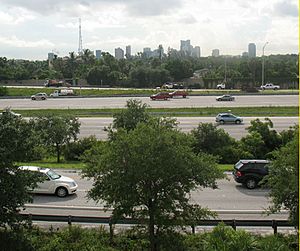
Broward County is served by three major Interstate Highways (I-75, I-95, I-595) and U.S. Highways, such as U.S. 1, US 27 and US 441. The interchange between I-95 and I-595/SR 862 is known as the Rainbow Interchange. It is also served by Florida's Turnpike and State Highway 869, also known as the Sawgrass Expressway.
Media and culture
Media
Fort Lauderdale is served by English-language newspapers South Florida-Sun Sentinel and The Miami Herald, Spanish-language newspapers El Sentinel and El Nuevo Herald, alternative newspaper New Times Broward-Palm Beach and city monthly Fort Lauderdale Magazine.
Culture
As is true of many parts of Florida, the city's population has a strong seasonal variation, as snowbirds from the northern United States, Canada, and Europe spend the winter and early spring in Florida. The city is also sometimes referred to as "Fort Liquordale" because of its beaches, bars, nightclubs, and history as a spring break location, back in the 1960s and 1970s, for tens of thousands of college students. However, the city has actively discouraged college students from visiting the area since the mid-1980s, passing strict laws aimed at preventing the mayhem that regularly occurred each year in the 1970s and 1980s. The city had an estimated 350,000 college visitors for spring break 1985; by 2006, that number had declined to about 10,000. Since the 1990s, Fort Lauderdale has increasingly become a location that caters to those seeking the resort lifestyle seasonally or year-round and is often a host city to many professional venues, concerts, and art shows.
Fort Lauderdale's arts and entertainment district, otherwise known as the Riverwalk Arts & Entertainment District, runs east-west along Las Olas Boulevard, from the beach to the heart of downtown. The district is anchored in the West by the Broward Center for the Performing Arts, and runs through the city to the intersection of Las Olas and A1A. This intersection is the "ground zero" of Fort Lauderdale Beach, and is the site of the Elbo Room bar featured in the 1960 film Where the Boys Are, which led in large measure to the city's former reputation as a spring break mecca. The city and its suburbs host over 4,100 restaurants and over 120 nightclubs, many of them in the arts and entertainment district. The city is also the setting for the 1986 movie Flight of the Navigator, and host of Langerado, an annual music festival. In 2013, the county welcomed about 1.3 million LGBT travelers who spent about $1.5 billion in area restaurants, hotels, attractions and shops, according to the Greater Fort Lauderdale Convention & Visitors Bureau.
Sites of interest
In addition to its museums, beaches, and nightlife, Fort Lauderdale is home to the Fort Lauderdale Swap Shop, a large indoor/outdoor flea market and the site of the world's largest drive-in movie theater, with 13 screens.
The International Swimming Hall of Fame is located on Fort Lauderdale beach, and houses a large aquatic complex as well as a museum, theater, and research library.
Hugh Taylor Birch State Park is a 180-acre (0.73 km2) park along the beach, with nature trails, camping and picnicking areas, canoeing, and features the Terramar Visitor Center, with exhibits about the ecosystem of the park. Hugh Taylor Birch came to Florida in 1893. He purchased ocean-front property for about a dollar per acre, he eventually owned a 3.5-mile stretch of beachfront. The Bonnet House is a historic home in Fort Lauderdale, Florida, United States. Bonnet House's modern history began when Birch gave the Bonnet House property as a wedding gift to his daughter Helen and her husband, Chicago artist Frederic Clay Bartlett in 1919. The site was listed on the National Register of Historic places in 1984 and declared a historic landmark by the City of Fort Lauderdale in 2002.
Henry E. Kinney Tunnel on U.S. Route 1 is the only tunnel on a state road in the state of Florida. It was constructed in 1960, and its 864-foot (263 m) length travels underneath the New River and Las Olas Boulevard.
The Florida Everglades is one of the most popular sites of interest among visitors to Fort Lauderdale. There are numerous services available to bring visitors from Fort Lauderdale Beach to the Everglades. Just minutes from the beach is the Riverwalk Arts and Entertainment District in downtown Fort Lauderdale, home to cultural attractions, shops, parks and restaurants. Along Riverwalk, the brick-lined meandering promenade, discover the Broward Center for the Performing Arts, Museum of Discovery and Science with its AutoNation 3D IMAX Theater, Florida Grand Opera, Fort Lauderdale Historical Center, Stranahan House and the Museum of Art.
Las Olas Boulevard is a popular thoroughfare in downtown Fort Lauderdale that runs from Andrews Avenue in the Central Business District to A1A and Fort Lauderdale Beach. The boulevard is a popular attraction for locals and visitors, being ideally situated close to Fort Lauderdale beach, Fort Lauderdale-Hollywood International Airport and Port Everglades. It is considered to be South Florida's most architecturally unique, authentic, and eclectic shopping and dining district.
Historic structures
The following are images of some of the remaining historical structures in Fort Lauderdale. Some are listed in the National Register of Historic Places:
-
The Bonnet House was built in 1895 and is located at 900 Birch Road. In 1919, the owner, Hugh Taylor Birch, gave the property to his daughter Helen and artist Frederic Clay Bartlett as a wedding gift. The property was listed in the National Register of Historic Places on July 5, 1984; reference #84000832.
-
The Stranahan House was built in 1901 and is located at 335 Southeast 6th. The lower floor of the house once served as a trading post and the upper floor as a community hall. The house also served as a general store and a bank. The house was listed in the National Register of Historic Places on October 2, 1973, reference #73000569.
-
The Hyatt Regency Hotel was built in 1957 and is located 2301 SE 17th Street. The hotel was designed by Richard F. Humble a follower of Frank Lloyd Wright.
Economy
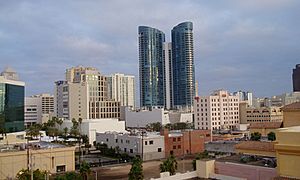
Fort Lauderdale's economy has diversified over time. From the 1940s through the 1980s, the city was known as a spring break destination for college students. The college crowd has since dwindled, however, with the city now attracting wealthier tourists. Cruise ships and nautical recreation provide the basis for much of the revenue raised by tourism. There is a convention center west of the beach and southeast of downtown, with 600,000 square feet (55,742 m2) of space, including a 200,000-square-foot (18,581 m2) main exhibit hall. Approximately 30% of the city's 10 million annual visitors attend conventions at the center.
The downtown area, especially around Las Olas Boulevard, first underwent redevelopment starting in 2002, and now hosts many new hotels and high-rise condominium developments. The city's central business district is the largest downtown in Broward County, although there are other cities in the county with commercial centers. Office buildings and high-rises include: Las Olas River House, Las Olas Grand, 110 Tower (formerly AutoNation Tower), Bank of America Plaza, One Financial Plaza, Broward Financial Center, One East Broward Boulevard, Barnett Bank Plaza, PNC Center, New River Center, One Corporate Center, SunTrust Centre, 101 Tower, and SouthTrust Tower.
Fort Lauderdale is a major manufacturing and maintenance center for yachts. The boating industry is responsible for over 109,000 jobs in the county. With its many canals, and proximity to the Bahamas and Caribbean, it is also a popular yachting vacation stop, and home port for 42,000 boats, and approximately 100 marinas and boatyards. Additionally, the annual Fort Lauderdale International Boat Show, the world's largest boat show, brings over 125,000 people to the city each year.
Top Employers
According to the Greater Fort Lauderdale Alliance 2020 report, the city's top employers include:
| Employer | Employees |
|---|---|
| AutoNation | 3,000 |
| Citrix | 1,700 |
| Kaplan | 1,291 |
| Rick Case Automotive Group | 905 |
| Sun-Sentinel | 897 |
Companies based in the Fort Lauderdale and Broward County area include, but not limited to: AutoNation, Citrix Systems, Commcare Pharmacy, DHL Express, KEMET Corporation, SEACOR Holdings, Spirit Airlines, and National Beverage Corporation. The largest employers in the county are Tenet Healthcare, which employs 5,000 people; American Express, which employs 4,200; FirstService Residential, which employs 3,900; Motorola, which employs 3,000; and Maxim Integrated Products, which employs 2,000.
Gulfstream International Airlines, a commuter airline, is headquartered in nearby Dania Beach.
Fort Lauderdale was recently listed as 2017's third best city out of 150 U.S. cities by WalletHub for summer jobs, and the 24th best city to start a career in.
Sports
Lockhart Stadium in Fort Lauderdale was the home of the Fort Lauderdale Strikers, which played in the most recent incarnation of the North American Soccer League. It was the home of the original Fort Lauderdale Strikers, which played in the previous version of the North American Soccer League. The Miami Fusion of Major League Soccer played home games at this stadium from 1998 to 2001. The Florida Atlantic University Owls football team played its home games at Lockhart Stadium from 2003 through 2010.
The New York Yankees, Baltimore Orioles, and Kansas City Royals used to conduct spring training in the city at Fort Lauderdale Stadium.
Fort Lauderdale is also home to the Fort Lauderdale Aquatic Complex, which is at the International Swimming Hall of Fame. It contains two 25-yard (23 m) by 50-meter competition pools, as well as one 20 by 25-yard (23 m) diving well. The complex is open to Fort Lauderdale residents, and has also been used in many different national and international competitions since its opening in 1965. Ten world records have been set there, from Catie Ball's 100 m breaststroke in 1966, to Michael Phelps' 400 m individual medley in 2002.
DRV PNK Stadium was opened in 2020 as the home of USL League One team Fort Lauderdale CF, and the temporary home of 2020 MLS expansion team Inter Miami CF, until the completion of Miami Freedom Park in Miami.
The War Memorial Auditorium has hosted professional wrestling, boxing, and mixed martial arts shows since its opening in 1950. In 2019, the Florida Panthers signed a 50-year lease with the venue, with plans to renovate it and add hockey facilities.
Education
According to 2000 census data, 79.0% of the city's population aged 25 or older were high school graduates, slightly below the national figure of 80.4%. Additionally, 27.9% held at least a baccalaureate, slightly higher than the national figure of 24.4%. Broward County Public Schools operates 23 public schools in Fort Lauderdale. The 2007 Florida Comprehensive Assessment Test (FCAT) results for Fort Lauderdale's public schools were mixed; while 10 (of 16) elementary schools and one (of four) middle schools received "A" or "B" grades, Sunland Park Elementary School and Arthur Ashe Middle School received failing grades. Boyd Anderson High School, which is in Lauderdale Lakes but whose attendance zone includes part of Fort Lauderdale, also received a failing grade. None of the three failing schools have failed twice in a four-year period, thus triggering the "Opportunity Scholarship Program" school choice provisions of the Florida's education plan.
Ten institutions of higher learning have main or satellite campuses in the city:
- The Art Institute of Fort Lauderdale
- Broward College BC (Willis Holcombe Downtown Center)
- City College
- Embry-Riddle Aeronautical University (satellite campus)
- Florida Atlantic University FAU (satellite campus)
- Florida International University FIU (satellite campus)
- Keiser University
- Jersey College
- Nova Southeastern University NSU
- University of Phoenix (Cypress Creek Learning Center)
Additionally, the Davenport, Iowa-based Kaplan University's Corporate headquarters and an academic support center are in the city.
Images for kids
-
Florida State Road A1A, north of Sunrise Blvd
See also
 In Spanish: Fort Lauderdale para niños
In Spanish: Fort Lauderdale para niños



